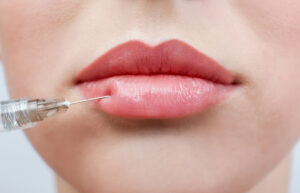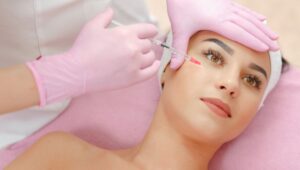Aesthetic treatments have come a long way over the years. Today society has been very open and accepting of these cosmetic procedures. Botox and dermal fillers being the frontrunners of the popularity boom for non-surgical aesthetic procedures.
Injectable fillers and Botox have both become extremely popular options to help people look younger. The reason for their popularity is mainly due to how effective they are at helping people reduce the signs of age without having to turn to invasive surgery.
Learn more about the uses and differences between Botox and dermal fillers.
Botox
Active Ingredient
Botox is an injectable drug made from botulinum toxin type A. This toxin is produced by the bacterium Clostridium botulinum. Botox is a toxin, but when doctors use it correctly and in small doses, it can have benefits. It has both cosmetic and medical uses. It has been considered safe in small doses for several decades.
Uses
Botox blocks signals from your nerves to your muscles. This prevents the targeted muscles from contracting, which can ease certain muscular conditions and improve the appearance of fine lines and wrinkles. It has been proven effective in the treatment of:
- crow’s feet
- frown lines or 11’s
- forehead creases
- chronic migraines
- excessive sweating (hyperhidrosis)
- eye twitching (blepharospasm)
- lazy eye (strabismus)
- limb spasticity
- neck spasms (cervical dystonia)
- overactive bladder (OAB)
- certain neurological conditions, such as Bell’s palsy
Efficacy
It generally takes 7 to 14 days to take full effect. The effects usually will last from 3 to 6 months. As muscle action slowly returns, the lines and wrinkles begin to reappear and need to be treated again. The lines and wrinkles often appear less severe with time because the muscles are shrinking.
Dermal Fillers
Dermal fillers, sometimes called soft tissue fillers, are substances designed to be injected beneath the surface of the skin to add volume and fullness.
Active Ingredients
Substances used in dermal fillers include:
Calcium hydroxylapatite, which is a mineral-like compound found in bones.
Hyaluronic acid, which is found in some fluids and tissues in the body that add plumpness to the skin.
Polylactic acid is a synthetic dermal filler that is injected into your face, causing your body’s own production of collagen.
Polymethyl-methacrylate microspheres (PMMA), a semi-permanent filler
Each one of these is designed to treat different signs of aging or other cosmetic issues.
Uses
Calcium hydroxyapatite dermal fillers are used for smoothing moderate to severe facial wrinkles and folds, such as nasolabial folds (the creases that extend from the corner of your nose to the corner of your mouth) and is also used for correcting volume loss in the back of the hands. (Radiesse®)
Hyaluronic acid fillers are used for smile lines, also called nasolabial folds, which run from the sides of the nose to the corners of the mouth, vertical lip lines, which form above the upper lip, corners of the mouth, which can turn downward and give the look of a constant frown and marionette lines, which begin at the corners of the mouth and extend down toward the chin. (Juvederm®, Juvederm Ultra®, Belotero®, Restylane®, Restylane Silk®)
Polylactic acid is known to work particularly well in the lower half of your face and is used to fill the lines caused by laughing, plump thin lips, and treat deep nasolabial folds. (Sculptra Aesthetic®)
Polymethyl-methacrylate microspheres (PMMA) is considered a semi-permanent filler and is most often used to treat medium-to-deep wrinkles, folds and furrows, particularly nasolabial folds. It can also be used to fill out pitted scars and to augment thin lips. (Bellafill®)
Efficacy
The time they take to work, as well as how long they last, also vary. Some fillers last 6 months, while others last up to 2 years or longer.
- Bellafill®: 8-10 Years
- Sculptra Aesthetic®: About 2 Years
- Juvederm®: About 6 Months
- Radiesse®: About 12 Months
- VOLBELLA®: Between 12-18 Months
- Restylane®: About 12 Months
- Belotero®: About 6 Months
- Juvederm Ultra®: About 4-6 Months
- Restylane Silk®: About 6 Months
Key Differences between Botox and Dermal Fillers
Botox
Botox works by targeting the nervous system, disrupting the nerve signaling processes that stimulate muscle contraction, causing temporary muscle paralysis,
In order for any muscle to contract, the nerves release a chemical messenger called acetylcholine at the junction where nerve endings meet muscle cells. Acetylcholine attaches to receptors on the muscle cells and causes the cells to contract, or shorten.
Botulinum toxin injections prevent the release of acetylcholine, which stops the muscle cells from contracting. In this way, the toxin helps the muscles to become more relaxed, when the underlying muscles relax it evens out the skin above it, softening the appearance of lines and wrinkles or completely vanishing them.
This injectable treatment works best for creases and wrinkles found in the upper face, like crow’s feet and frown lines.
Results last 3 to 4 months.
Dermal Fillers
These are injectable treatments that use hyaluronic acid and similar substances to “fill in” or plump areas that have lost volume and smoothness. This includes wrinkles around the mouth, thin lips, and cheeks that have lost fullness. They may also be used on forehead wrinkles, scars, and other areas that need extra volume for a smoother look.
Injectable fillers’ results vary, depending on which filler is used.
Botox AND Fillers
Because Botox and fillers are different substances designed for different uses, they can sometimes be combined in one treatment. For instance, someone may use Botox to correct lines between the eyes and a filler to correct smile lines around the mouth.
They can also be used in combination, like James Christian Cosmetic’s signature Fox Eye Lift, merging the muscle-relaxing effects of Botox and the volume-enhancing properties of fillers to achieve the best results.
Get in touch with one of our professional injectors at James Christian Cosmetics through our 24/7 Cosmetic Concierge lines by texting or calling us at 917-860-3113 for our New York offices and 305-849-0307 for our newly opened Miami office. Book a free consultation, our injectable experts would welcome all your questions.
We aim to provide all of our clients with excellent personalized care and amazing results that provide them with natural-looking youthful beauty. We have been serving satisfied New York residents for over a decade and have recently added Miami residents to the list of our satisfied clients with the newly opened branch at 1800 Bay Rd, Miami Beach, FL.
*Information in this article is not medical advice and may not be factually accurate. It is intended for entertainment purposes only. Consult with a physician before attempting any tips in this blog post and to get the most up to date factual data about any procedure or treatment.














